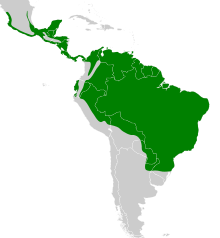Boat-billed flycatcher
| Boat-billed flycatcher | |
|---|---|

| |
| Scientific classification | |
| Kingdom: | Animalia |
| Phylum: | Chordata |
| Class: | Aves |
| Order: | Passeriformes |
| Family: | Tyrannidae |
| Genus: | Megarynchus |
| Species: | M. pitangua
|
| Binomial name | |
| Megarynchus pitangua (Linnaeus, 1766)
| |

| |
| Synonyms | |
| |
The boat-billed flycatcher (Megarynchus pitangua) is a passerine bird. It is a large tyrant flycatcher, the only member of the monotypic genus Megarynchus.
It breeds in open woodland with some tall trees from Mexico south to Bolivia and Argentina, and through to Trinidad.
The nest, built by the female, is an open saucer of sticks. The typical clutch is two or three whitish eggs heavily blotched with brown. These are incubated mostly by the female for 17–18 days with a further 24 days to fledging.
Description[]

Adult boat-billed flycatchers are one of the largest species of tyrant flycatcher, measuring 23 cm (9.1 in) long and weighing 70 g (2.5 oz).[2] The head is black with a strong white eyestripe and a concealed yellow crown stripe. The upperparts are olive-brown, and the wings and tail are brown with only faint rufous fringes. The underparts are yellow and the throat is white.
The massive black bill, which gives this species its English and generic names, is the best distinction from the similar great kiskadee, which also has more rufous tail and wings, and lacks the olive tone to the upperparts. The call is a strident trilled nya, nya, nya.
Diet[]
Boat-billed flycatchers wait on a concealed perch high in a tree and sally out to catch insects in flight. They will also take invertebrates off the foliage and eat some berries.
References[]
- ^ BirdLife International (2016). "Megarynchus pitangua". IUCN Red List of Threatened Species. 2016: e.T22700533A93783432. doi:10.2305/IUCN.UK.2016-3.RLTS.T22700533A93783432.en. Retrieved 11 November 2021.
- ^ "Boat-billed Flycatcher". Gandoca-Manzanillo Wildlife Refuge, Costa Rica.
Further reading[]
- Skutch, Alexander F. (1960). "Boat-billed flycatcher" (PDF). Life Histories of Central American Birds II. Pacific Coast Avifauna, Number 34. Berkeley, California: Cooper Ornithological Society. pp. 353–355.
External links[]
| Wikimedia Commons has media related to Megarynchus pitangua. |
| Wikispecies has information related to Megarynchus pitangua. |
- "Boat-billed Flycatcher media". Internet Bird Collection.
- Boat-billed Flycatcher photo gallery at VIREO (Drexel University)
- Boat-billed Flycatcher species account at Neotropical Birds (Cornell Lab of Ornithology)
- Interactive range map of Megarynchus pitangua at IUCN Red List maps
- IUCN Red List least concern species
- Tyrannidae
- Birds of the Amazon Basin
- Birds of the Guianas
- Birds of the Cerrado
- Birds of the Caatinga
- Birds of the Pantanal
- Birds of Trinidad and Tobago
- Birds of Central America
- Birds of South America
- Birds of the Yucatán Peninsula
- Higher-level bird taxa restricted to the Neotropics
- Birds described in 1766
- Taxa named by Carl Linnaeus
- Tyrant flycatcher stubs
